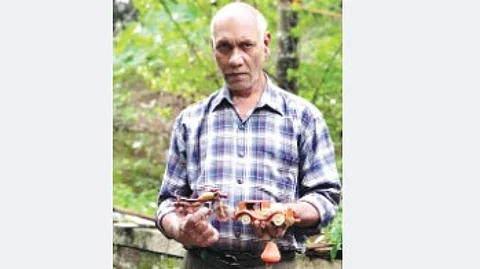

JENIFER FERNANDES
joseph@herald-goa.com
ALDONA: In the quiet village of Corjuem, lives Yeshwant N. Sanjgiri, a 61-year-old retired defence officer whose humility and simplicity stand in sharp contrast to the rich legacy of talent and tradition he carries. Though far
removed from the regimented life of the military, Sanjgiri’s days remain marked by precision, discipline, and purpose—this time, through the world of traditional craftsmanship.
From the age of 10, Sanjgiri nurtured a passion for art and craft, lovingly passed down by his parents and grandparents. “Even after retirement, I chose not to sit idle,” he says. “Instead, I embraced what I love most—working with my hands.” Today, he is known as a skilled carpenter, potter, and net-maker, specialising in crab nets that serve as vital tools for local fishermen.
But his craftsmanship goes far beyond function. Sanjgiri sells a variety of handmade items at markets in Bicholim and Sanquelim, where he has built a loyal clientele over the years. With help from two agents who manage orders and expand his outreach, his humble talent now touches more lives than ever.
“I find immense pride and peace in my work,” he reflects. “Each piece I create carries the essence of heritage, experience, and dedication. Crafting is not just a livelihood—it’s my life.”
His knowledge is deeply rooted in family tradition. From his grandfather, he inherited the intricate art of net-making—a skill demanding patience, steady hands, and a sharp eye. “You must sit for hours, knotting each thread carefully to ensure strength. It’s not a job for the restless,” he laughs.
His creative journey began early. At just 12, Sanjgiri crafted a Lord Ganesha idol entirely out of paper—a creation so meaningful that his grandfather placed it on the family mandap and performed a traditional immersion ceremony. “That was one of the proudest moments of my life,” he recalls.
He also learned patchwork from his grandmother, sitting beside her for hours and absorbing her quiet
dedication. “She didn’t speak much, but her hands taught me everything I needed
to know.”
Sanjgiri’s ingenuity lies not only in traditional technique but in his ability to see value in waste. Old newspapers are transformed into clay and molded into ceramic-like items. Used tissue paper is soaked and pulped into decorative fruits. Even soft drink bottles, often discarded, are turned into flower pots and dolls. “It’s all about perspective,” he says. “Where others see trash, an artist sees potential.”
Nature is another major source of inspiration. “A coconut tree, from root to leaf, has nothing that goes to waste. Similarly, the sea throws up driftwood and shells—raw materials that, with some imagination, can become art.”
His experiments range from boats made out of M-Seal to decorative pieces crafted from scrap. “You don’t need a hotel job or an office desk to earn a living. If you’re creative, craftsmanship can offer you a dignified and fulfilling life.”
But Sanjgiri is deeply concerned about today’s generation. “Many children dream of getting rich quickly, forgetting that real success comes from patience and hard work,” he warns. “Parents must take the lead in teaching them the value of our traditional arts.”
He believes schools and homes should actively encourage hands-on creativity—teaching kids how to make toy cars, chairs, or simple tables using wood. “This not only builds creativity but also imparts life skills,”
he adds.
His routine begins at 6 a.m., working until noon, crafting nets or preparing materials. “As long as my hands work and my heart is willing, I will continue,” he says.
In Maharashtra, he notes, the government actively supports artisans—a model he wishes to see replicated in Goa. He remains eager to share his knowledge, welcoming any child interested in learning. “Let them come to me, tell me how many days they wish to learn—I will gladly teach them.”
From defence to design:
For Yeshwant, art is more than aesthetics—it is a philosophy, a way of life, and a quiet rebellion against wastefulness and monotony. His journey proves that with vision, even discarded items can tell stories—and that true artistry lies in finding beauty in the overlooked